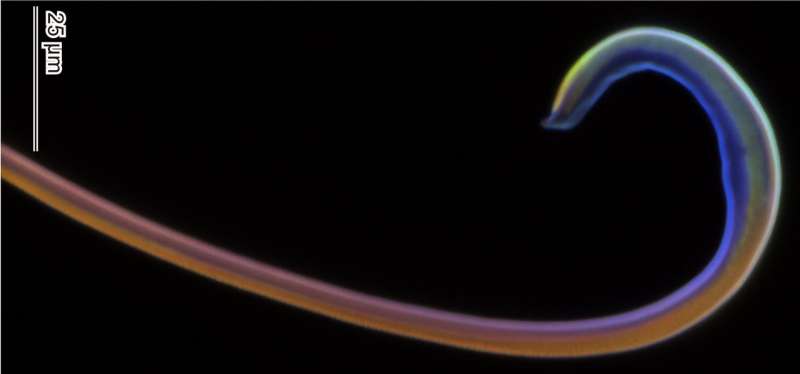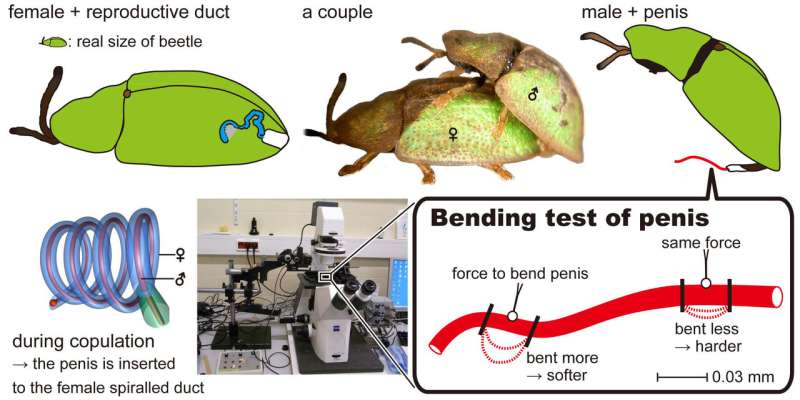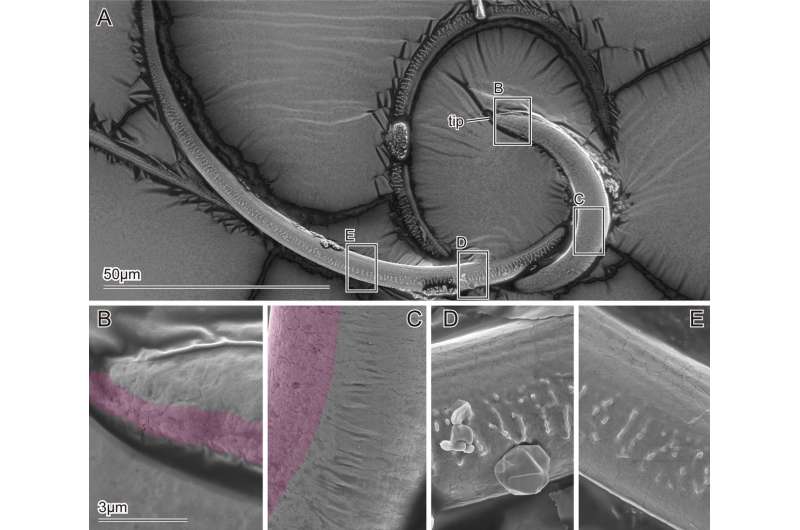December 21, 2017 report
Study of beetle flagellum offers possible way to improve medical devices

A trio of researchers at Kiel University in Germany has discovered how the male thistle tortoise beetle manages to penetrate the coiled duct inside the female reproductive organ without buckling his flagellum. In their paper published on the open access site Science Advances, Yoko Matsumura, Alexander Kovalev and Stanislav Gorb describe their study of the flagellum and what they found.
The small green male thistle tortoise beetle has a flagellum (male sex organ) that is actually longer than its body—the organ is also very thin and curved at the end. The beetle needs such an organ because of the shape of the female reproductive organ, which includes a coiled duct that the male must penetrate. What is most impressive about the flagellum, the researchers note, is that its tip can make the journey from the outside to the inside without the shaft buckling. This suggested that there was more to the story than could be seen with the naked eye.
To better understand how the beetle flagellum is able to prevent buckling, the researchers lopped off several of them from beetles they had killed and looked at them under a microscope. They noted first that the tip was curved like a fish hook, which is important when maneuvering through a coil, so long as the curve of the flagellum tip matches the curve of the coil. They also found by bending the flagellum at different points along its shaft that it varied in stiffness—the base was quite stiff, but the shaft grew less stiff toward its opposite end. And the tip, they found, was actually rubbery, allowing for flexibility inside the female organ.

The researchers believe it is both the changing flexibility and rubbery tip that allows the flagellum to move inside the female organ without buckling—a characteristic that could prove useful in human products, such as catheters. Catheters, the team notes, are used in urological, gastrointestinal and cardiovascular medical procedures. Each requires a thin tube to be inserted into a small vessel and slide into it to some degree. Modifying the stiffness of the tubes, the team notes, might help prevent buckling.

More information: Yoko Matsumura et al. Penetration mechanics of a beetle intromittent organ with bending stiffness gradient and a soft tip, Science Advances (2017). DOI: 10.1126/sciadv.aao5469
Abstract
Hyper-elongated structures and their penetration are widespread among insects, for example, intromittent organs, ovipositors, and piercing-sucking mouthparts. The penetration of thin structures with high aspect ratio without buckling and rupturing is mechanically very challenging. However, this problem is economically solved in nature, and the solutions might be helpful for, for example, in the development of harmless catheters. We focus on the penetration process of a hyper-elongated structure of a cassidine beetle intromittent organ, termed a flagellum. We applied a three-point bending test for the flagellum to measure its bending stiffness along the entire flagellum. We demonstrated the bending stiffness gradient, in which the basal half is relatively stiff and the apical half is softer, whose good performance during copulation had been previously numerically demonstrated. The stiffness gradient is the result of the flagellum shape, which is cylindrical and tapered toward the tip. Moreover, the curved tip comprises a harder outer curve and a softer inner curve. Considering the findings of preceding studies, the flagellum works in the following way: (i) the bending stiffness gradient supports the flagellum, easily fitting to a shape of a highly coiled spermathecal duct, (ii) the stiffness property of the very tip may make the tip tougher, and (iii) the curled tip and homogeneously cylindrical shape of the organ help the very tip to fit the shape of the spermathecal duct of the female. Our study shows that the apparently simple flagellum penetration is achieved with numerous elaborate mechanical adaptations.
Journal information: Science Advances
© 2017 Phys.org





















